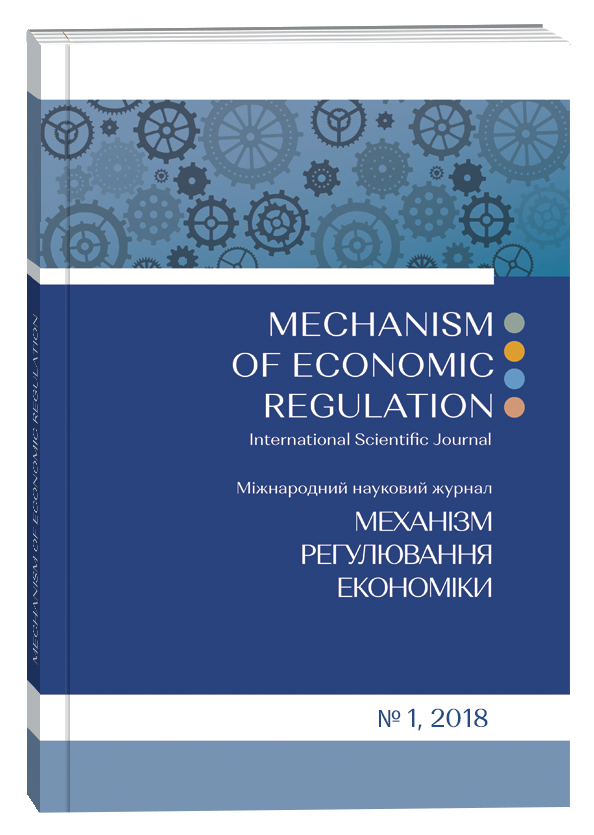MODERN APPROACHES TO THE HYSTERESIS ANALYSIS IN ECONOMIC SYSTEMS AND EU EXPERIENCE
Abstract
The article analyses the hysteresis methods of analysis of economic systems. The causes and consequences of hysteresis are considered. The spheres of hysteresis manifestation, their common and distinctive features are analysed. The role of the phenomenon of hysteresis in macroeconomics phenomena as well as in some other spheres of economic science has been determined. A generalizing analysis of hysteresis on the examples on micro- and macro-level its impact in various situations was conducted. The role of hysteresis on the example of cyclic phenomena in economic development is disclosed. The possibility of determining the common features of the manifestation of hysteresis in various cases on data from open sources is analysed. A comparative analysis of modern European studies in this area is conducted on the example of the some EU countries. A method of expanding the scope of hysteresis in the economy is proposed.
References
Aray, H. (2015). Hysteresis and import penetration with decreasing sunk entry costs. International Economics and Economic Policy, 12(2), 175-188. doi:10.1007/s10368-014-0269-8
Bassi, F., & Lang, D. (2016). Investment hysteresis and potential output: A post-Keynesian– Kaleckian agent-based approach. Economic Modelling, 52, 35-49.
doi:10.1016/j.econmod.2015.06.022
Belke, A., Göcke, M., & Günther, M. (2013). Exchange rate bands of inaction and play-hysteresis in German exports-sectoral evidence for some OECD destinations. Metroeconomica, 64(1), 152-179. doi:10.1111/meca.12000
Belke, A., Göcke, M., & Werner, L. (2013). Hysteresis Effects in Economics – Different Methods for Describing Economic Path-dependence. Bochum: Ruhr-Universität Bochum.
Congregado, E., Golpe, A. A., & Parker, S. C. (2012). The dynamics of entrepreneurship: hysteresis, business cycles and government policy. Empirical Economics, 43(3), 1239-1261. doi:10.1007/s00181-011-0516-6
Cross, R. (2008). Mach, methodology, hysteresis and economics. Journal of Physics: Conference Series, 138. doi:10.1088/1742-6596/138/1/012004
Cross, R. (2011). In memory of Alexei Pokrovskii: His hysteresis effect on economics. Journal of Physics: Conference Series, 268. doi:10.1088/1742-6596/268/1/011004
Cross, R., Grinfeld, M., & Lamba, H. (2009). Hysteresis and economics. IEEE Control Systems Magazine, 29(1), 30-43. doi:10.1109/mcs.2008.930445
Delgado, F., Dumas, B., & Puopolo, G. W. (2015). Hysteresis bands on returns, holding period and transaction costs. Journal of Banking & Finance, 57, 86-100. doi:10.1016/j.jbankfin.2014.12.015
Dixit, A. (1989). Hysteresis, Import Penetration, and Exchange Rate Pass-Through. The Quarterly Journal of Economics, 104(2), 205-228. doi:10.2307/2937845
Engler, P., & Tervala, J. (2018). Hysteresis and fiscal policy. Journal of Economic Dynamics and Control. https://doi.org/10.1016/j.jedc.2018.02.002
Franz, W. (1990). Hysteresis Effects in Economic Models. Heidelberg: Physica-Verlag HD.
Gherhes, C., Vorley, T., & Williams, N. (2017). Entrepreneurship and local economic resilience: The impact of institutional hysteresis in peripheral places. Small Business Economics. doi:10.1007/s11187-017-9946-7
Göcke, M. (2002). Various Concepts of Hysteresis Applied in Economics. Journal of Economic Surveys, 16(2), 167-188. doi:10.1111/1467-6419.00163
Göcke, M., & Werner, L. (2015). Play Hysteresis in Supply or in Demand as Part of a Market Model.
Metroeconomica, 66(2), 339-374. doi:10.1111/meca.12074
Hinrichs, J., Mußhoff, O., & Odening, M. (2008). Economic hysteresis in hog production. Applied Economics, 40(3), 333-340. doi:10.1080/00036840500447880
Hurchenkov, A. A., & Fesechko, A. I. (2011). Mathematics in economics (hysteresis). Papers of Annual International Symposium “Reliability & Quality”, 1, 21-24.
Krasnoselskii, M. A. and Pokrovskii, A. V. (1983). Sistemy s Gisteresisom. Moscow: Nauka.
Kienzler, D., & Schmid, K. D. (2014). Hysteresis in Potential Output and Monetary Policy. Scottish Journal of Political Economy, 61(4), 371-396. doi:10.1111/sjpe.12050
Krupkina, A., & Ponomarenko, A. (2017). Deposit dollarization in emerging markets: Modelling the hysteresis effect. Journal of Economics and Finance, 41(4), 794-805. doi:10.1007/s12197-016-9379- 1
Libman, E. (2018). Endogenous norms in wage and price setting and hysteresis in the real exchange rate. Metroeconomica. doi:10.1111/meca.12200
Martin, R. (2012). Regional economic resilience, hysteresis and recessionary shocks. Journal of Economic Geography, 12(1), 1-32. doi:10.1093/jeg/lbr019
Mehta, A., & Chavas, J. (2008). Responding to the coffee crisis: What can we learn from price dynamics? Journal of Development Economics, 85(1-2), 282-311. doi:10.1016/j.jdeveco.2006.07.006
Mourougane, A. (2017). Crisis, potential output and hysteresis. International Economics, 149, 1-14. doi:10.1016/j.inteco.2016.07.001
Ordonez-De-Haro, J. M., & Torres, J. L. (2014). Price hysteresis after antitrust enforcement: evidence from Spanish food markets. Journal of Competition Law and Economics, 10(1), 217-256. doi:10.1093/joclec/nht029
Schmitt, N., Tuinstra, J., & Westerhoff, F. (2017). Side effects of nonlinear profit taxes in an evolutionary market entry model: Abrupt changes, coexisting attractors and hysteresis problems. Journal of Economic Behavior & Organization, 135, 15-38. doi:10.1016/j.jebo.2017.01.008
Stiassny, A. (1998). Wage Setting and Hysteresis in Unemployment. Empirica, 25(1), 79-107. doi:10.1023/a:1006855218158
Tubadji, A., Nijkamp, P., & Angelis, V. (2016). Cultural hysteresis, entrepreneurship and economic crisis. Cambridge Journal of Regions, Economy and Society, 9(1), 103-136. doi:10.1093/cjres/rsv035


